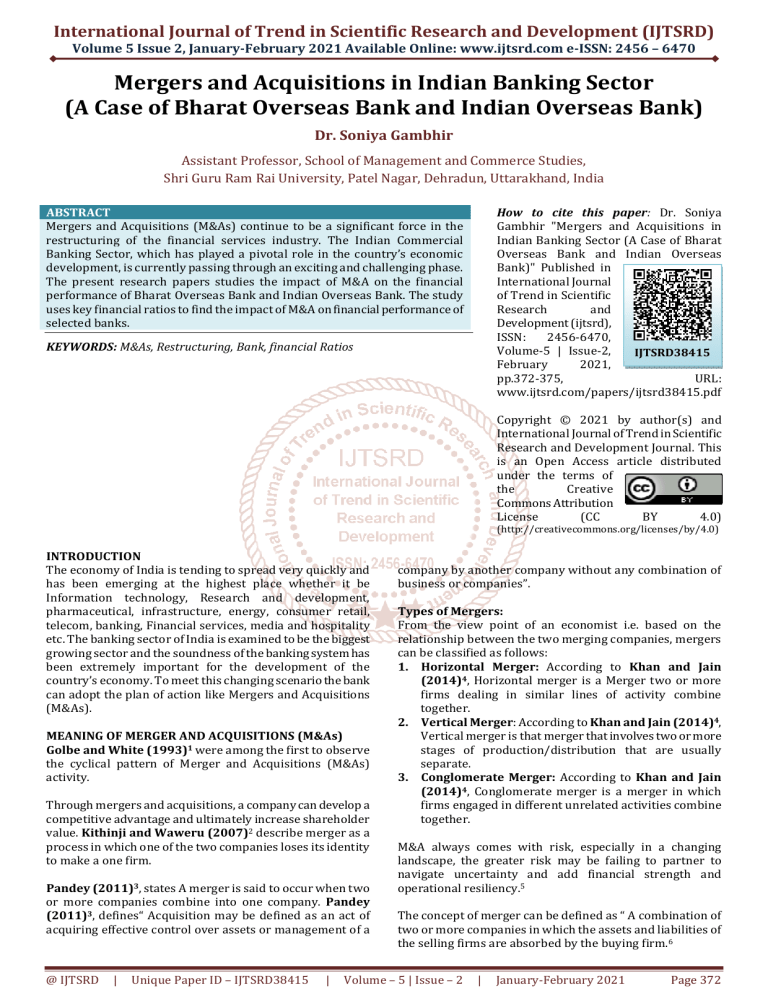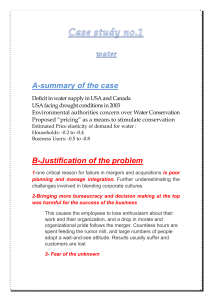
International Journal of Trend in Scientific Research and Development (IJTSRD)
Volume 5 Issue 2, January-February 2021 Available Online: www.ijtsrd.com e-ISSN: 2456 – 6470
Mergers and Acquisitions in Indian Banking Sector
(A Case of Bharat Overseas Bank and Indian Overseas Bank)
Dr. Soniya Gambhir
Assistant Professor, School of Management and Commerce Studies,
Shri Guru Ram Rai University, Patel Nagar, Dehradun, Uttarakhand, India
How to cite this paper: Dr. Soniya
Gambhir "Mergers and Acquisitions in
Indian Banking Sector (A Case of Bharat
Overseas Bank and Indian Overseas
Bank)" Published in
International Journal
of Trend in Scientific
Research
and
Development (ijtsrd),
ISSN:
2456-6470,
Volume-5 | Issue-2,
IJTSRD38415
February
2021,
pp.372-375,
URL:
www.ijtsrd.com/papers/ijtsrd38415.pdf
ABSTRACT
Mergers and Acquisitions (M&As) continue to be a significant force in the
restructuring of the financial services industry. The Indian Commercial
Banking Sector, which has played a pivotal role in the country’s economic
development, is currently passing through an exciting and challenging phase.
The present research papers studies the impact of M&A on the financial
performance of Bharat Overseas Bank and Indian Overseas Bank. The study
uses key financial ratios to find the impact of M&A on financial performance of
selected banks.
KEYWORDS: M&As, Restructuring, Bank, financial Ratios
Copyright © 2021 by author(s) and
International Journal of Trend in Scientific
Research and Development Journal. This
is an Open Access article distributed
under the terms of
the
Creative
Commons Attribution
License
(CC
BY
4.0)
(http://creativecommons.org/licenses/by/4.0)
INTRODUCTION
The economy of India is tending to spread very quickly and
has been emerging at the highest place whether it be
Information technology, Research and development,
pharmaceutical, infrastructure, energy, consumer retail,
telecom, banking, Financial services, media and hospitality
etc. The banking sector of India is examined to be the biggest
growing sector and the soundness of the banking system has
been extremely important for the development of the
country’s economy. To meet this changing scenario the bank
can adopt the plan of action like Mergers and Acquisitions
(M&As).
MEANING OF MERGER AND ACQUISITIONS (M&As)
Golbe and White (1993)1 were among the first to observe
the cyclical pattern of Merger and Acquisitions (M&As)
activity.
Through mergers and acquisitions, a company can develop a
competitive advantage and ultimately increase shareholder
value. Kithinji and Waweru (2007)2 describe merger as a
process in which one of the two companies loses its identity
to make a one firm.
Pandey (2011)3, states A merger is said to occur when two
or more companies combine into one company. Pandey
(2011)3, defines“ Acquisition may be defined as an act of
acquiring effective control over assets or management of a
@ IJTSRD
|
Unique Paper ID – IJTSRD38415
|
company by another company without any combination of
business or companies”.
Types of Mergers:
From the view point of an economist i.e. based on the
relationship between the two merging companies, mergers
can be classified as follows:
1. Horizontal Merger: According to Khan and Jain
(2014)4, Horizontal merger is a Merger two or more
firms dealing in similar lines of activity combine
together.
2. Vertical Merger: According to Khan and Jain (2014)4,
Vertical merger is that merger that involves two or more
stages of production/distribution that are usually
separate.
3. Conglomerate Merger: According to Khan and Jain
(2014)4, Conglomerate merger is a merger in which
firms engaged in different unrelated activities combine
together.
M&A always comes with risk, especially in a changing
landscape, the greater risk may be failing to partner to
navigate uncertainty and add financial strength and
operational resiliency.5
The concept of merger can be defined as “ A combination of
two or more companies in which the assets and liabilities of
the selling firms are absorbed by the buying firm.6
Volume – 5 | Issue – 2
|
January-February 2021
Page 372
International Journal of Trend in Scientific Research and Development (IJTSRD) @ www.ijtsrd.com eISSN: 2456-6470
M&As in the banking sector have been on the rise in the
recent past, both globally and in India. The International
banking scenario has shown major turmoil in the past few
years in terms of mergers and acquisitions. Deregulation has
been the main driver, through three major routes:
dismantling of interest rate controls, removal of barriers
between banks and other financial intermediaries, and
lowering of entry barriers.
The Success of these M&A’s depends on to a large extent
upon a banks ability to assess the relatedness of the assets of
both banks and the cultural differences as well as to being
able to integrate and the cultural differences as well as to
able to integrate the two banks”7
Merger of Bharat Overseas Bank (BOB) and Indian
Overseas Bank (IOB)
Bharat Overseas Bank was established in the year 1973. It
was a private sector bank based in Chennai. In the year 2007,
BOB was merged with IOB. IOB tool over all employees,
assets and deposit of BOB. The bank with a network of 103
branches was taken over by Indian Overseas Bank on March
3, 2007.
REVIEW OF LITERATURE
Most of the mergers are actually acquisitions in banking
sector. An organization or a business actually buys another
business and integrate it into its own business
representation
Bansal and Kumar (2008)8, evaluates that while moving
towards mergers and acquisitions, the management of the
company smells financial strategy and operating strategy in
different ways. The study focuses on finding out that when
the firm goes for M&A activity, the claims made by the
corporate sector are being achieved or not in Indian context.
For the purpose of analysis secondary financial data of
various firms has been taken. Ratio analysis, correlation has
been used for analysis.
Jalandhar, et al. (2011)9, examined the performance
evaluation of Indian Commercial Banks in terms of growth in
Profitability, Revenues, Investment, Deposits and Total
Assets. Bank mergers do not mean merging of two Balance
sheets. After merger the biggest challenge for the banks is to
manage employees and customer relationships. The
researcher further concluded that the real benefits of merger
is derived from development in technology, the need to
maintain economic capital in relation to the risks a bank is
exposed to, and the imperative of confronting to best
international practices and standards in risk management.
Sinha P. and Gupta S. (2011)10, analyses the data for of
eighty cases M&A from 1993-2010. The study indicates that
Profit after tax and Profit before Depreciation, Interest and
Tax have positively changed after the merger but the
liquidity position which is represented by Current Ratio has
declined. After Merger it came to find that companies may
have been able to leverage the synergies arising out of
merger and Acquisition that have not been able to manage
their liquidity.
@ IJTSRD
|
Unique Paper ID – IJTSRD38415
|
Deverajjappa (2012)11, explores the various reasons for
merger in Indian Banking sector. The study is based on pre
and post merger financial performance of Indian banks by
analyzing various financial parameters like Gross profit
margin, Net profit margin, operating profit margin, Return
on capital employed, Return on equity, Debt equity ratio. The
study uses Independent T-test to find significance level. The
result concluded that after merger the financial performance
have been increased.
Kouser and Saba (2012)12, in the study examines the
CAMEL model. The paper states that CAMEL is a suitable and
simple model for evaluating the financial and managerial
performance of banks. The paper evaluates that CAMEL is
the most commonly used model for the assessment of
performance and ranking. The ratios based on CAMEL model
were analyzed using ANOVA to find out the significant
difference between pre and post merger period.
Objectives of the Study
The present study is proposed to evaluate the financial
performance of Bharat Overseas Bank and Indian Overseas
Bank before and after the merger.
Hypothesis of the study
Ho = There would be no significant effect of Mergers and
Acquisition on financial performance on selected
Banks.
H1 = There would be significant effect of Mergers and
Acquisition on financial performance on selected
banks.
Data and Methodology
For the purpose of evaluating the financial performance
before and after Merger and Acquisition a case of Bharat
Overseas Bank and Indian Overseas Bank is selected through
judgment as sample case.
The empirical study analyses the financial data of the merged
banks before and after the merger. Since the merger took
place in 31/03/2007 so, the financial analysis has been done
for the year 2002 to 2006 (pre-merger) and from 2007 to
2012 (post-merger). The analysis has been done on the basis
of key financial ratios using t-test. The data has been collected
from secondary source using CAPITAL LINE database
Bharat Overseas Bank & Indian Overseas Bank
Analysis & Interpretation of Bharat Overseas Bank
based on T-Test
The Descriptive table 1 displays the sample size, mean,
standard deviation, and standard error for both Pre and
Post-Merger banks. On average after merger, the capital
adequacy ratio of Bharat overseas bank decreased by 1.27%,
total advance to total asset increased by 11.76%, Credit
deposit ratio increased by 17.79%, Investment Deposit Ratio
decreased by 2.44%, Cash deposit Ratio increased by 2.48%,
Dividend payout ratio is increased by 9.41%, Return on
Assets is increased by 0.08%, Return on Equity is increased
by 4.25%,
Volume – 5 | Issue – 2
|
January-February 2021
Page 373
International Journal of Trend in Scientific Research and Development (IJTSRD) @ www.ijtsrd.com eISSN: 2456-6470
Table1: Group Statistics of Bharat Overseas Bank
Group Statistics
Pre-Post-Merger
N
Mean
Std. Deviation
Pre-Merger 5 14.1660
1.85284
Capital Adequacy Ratio
Post-Merger 6 12.8983
.89602
Pre-Merger 5 49.1220
4.61344
Total Adv. to Total Asset Ratio Post-Merger 6 60.8750
2.45862
Post-Merger 6 73.6723
3.90562
Pre-Merger 5 55.1600
5.12518
Credit Deposit Ratio (%)
Post-Merger 6 72.9483
3.31435
Pre-Merger 5 35.9620
2.14260
Investment ratio (%)
Post-Merger 6 33.5250
1.45352
Pre-Merger 5 4.7400
.39799
Cash Deposit Ratio (%)
Post-Merger 6 7.2150
1.12269
Post-Merger 6
.0417
.00753
Pre-Merger 5 15.0100
11.59527
Divident Payout ratio
Post-Merger 6 24.4150
8.31206
Pre-Merger 5
.8540
.46317
Return on Assets (%)
Post-Merger 6
.9317
.38881
8.57763
Pre-Merger 5 15.6160
Return on equity (%)
Post-Merger 6 19.8583
8.33152
Std. Error Mean
.82862
.36580
2.06319
1.00373
1.59446
2.29205
1.35308
.95820
.59340
.17799
.45834
.00307
5.18556
3.39338
.20714
.15873
3.83603
3.40133
Analysis & Interpretation of Indian Overseas Bank based on T-Test
The Descriptive table 2 displays the sample size, mean, standard deviation, and standard error for both Pre and Post-Merger
banks. On average after merger, the capital adequacy ratio of Indian overseas bank increased by 0.52%, total advance to total
asset increased by 9.08%, Credit deposit ratio increased by 20.96%, Investment Deposit Ratio decreased by 12.44%, Cash
deposit Ratio decreased by 1.06%, Dividend payout ratio is increased by 4.075%, Return on Assets is decreased by 0.13, Return
on Equity is decreased by 10.84.
Table 2: Group Statistics of Indian Overseas Bank
Group Statistics
Pre-Post-Merger
N
Mean
Std. Deviation
1.35981
Pre-Merger 5 12.3720
Capital Adequacy Ratio
Post-Merger 6 12.8983
.89602
Pre-Merger 5 51.7920
10.09089
Total Adv. to Total Asset Ratio
Post-Merger 6 60.8750
2.45862
Pre-Merger 5 51.9860
6.70551
Credit Deposit Ratio (%)
Post-Merger 6 72.9483
3.31435
Pre-Merger 5 45.9680
3.83104
Investment ratio (%)
Post-Merger 6 33.5250
1.45352
Pre-Merger 5 8.2780
1.14034
Cash Deposit Ratio (%)
Post-Merger 6 7.2150
1.12269
Pre-Merger 5 20.3400
2.33362
Divident Payout ratio
Post-Merger 6 24.4150
8.31206
Pre-Merger 5 1.0680
.26771
Return on Assets (%)
Post-Merger 6
.9317
.38881
Pre-Merger 5 30.7080
3.84803
Return on equity (%)
Post-Merger 6 19.8583
8.33152
Conclusion:
A bank merger helps the institution to scale up quickly and
gain a large number of new customers instantly. The markets
seem to be in favor of bank consolidation. The Merger of BOB
and IOB increased the number of branches as well as
employee, assets and deposits.
@ IJTSRD
|
Unique Paper ID – IJTSRD38415
|
Std. Error Mean
.60812
.36580
4.51278
1.00373
2.99879
1.35308
1.71329
.59340
.50997
.45834
1.04363
3.39338
.11972
.15873
1.72089
3.40133
REFERENCES
[1] Golbe, D. L. and White, L. J. (1993). Catch a Wave: The
Time Series Behaviour of Mergers. Review of
Economics and Statistics 75, 493-497.
[2]
Kithinji, A. M. and Waweru, N. M. (2007). Merger
Restructuring and Financial Performance of
Volume – 5 | Issue – 2
|
January-February 2021
Page 374
International Journal of Trend in Scientific Research and Development (IJTSRD) @ www.ijtsrd.com eISSN: 2456-6470
Commercial Banks In Kenya. Journal of Economics,
Management and Financial Markets, Vol. 2, No. 4.
[3]
Pandey(2011), financial Management, Vikas, Edition
10, pp. 758.
[4]
Khan & Jain, (2014), Financial Management, Mc-Graw
Hill, Edition 7, PP. 33. 2-33. 3
[5]
https://www2.deloitte.com/us/en/pages/financialservices/articles/banking-securities-mergersacquisitions-outlook.html
[6]
mergers & acquisitions from a to z, second edition by
andrew j. sherman; milledge a. hart
[7]
marks, m. l., mirvis, p. h. (2011), merge ahead. a
research agenda to increase merger and acquisition
success. journal of business psychology, vol. 26, pp.
161-168
[8]
Kumar, S., & Bansal, L. K. (2008). The impact of
mergers and acquisitions on corporate performance
in India. Management Decision, 46(10), 1531-1543.
@ IJTSRD
|
Unique Paper ID – IJTSRD38415
|
[9]
Jalandhar P, AnchulaB. D, Achari(2011), Performance
Evaluation of Selected Indian Commercial Banks: A
Critical study in their Post Merger Period.
International Journal of Current Research, 3(6), 196201
[10]
Sinha, P., & Gupta, S. (2011). Mergers and
Acquisitions: A pre-post analysis for the Indian
financial services sector.
[11]
Devarajappa, S. (2012). Mergers in Indian banks: a
study on mergers of HDFC bank ltd and centurion
bank of Punjab ltd. International Journal of Marketing,
Financial Services & Management Research, 1(9), 3342.
[12]
Khan A. A. (2012). Post Merger Financial Performance
Appraisal of Acquiring Banks in India, A Case
Analysis. International journal of Research in
Commerce & Management. 3(7), 172-175
[13]
www.capitaline.com
[14]
https://www.rbi.org.in/scripts/BS_ViewBulletin.aspx
?Id=9312
Volume – 5 | Issue – 2
|
January-February 2021
Page 375


